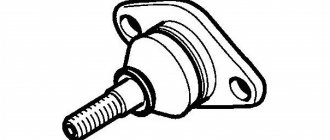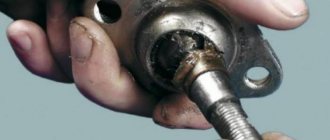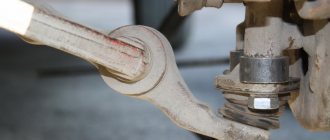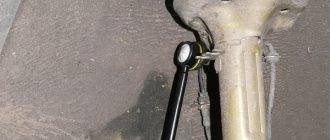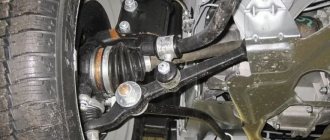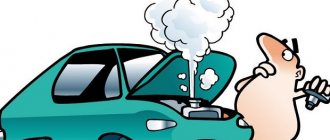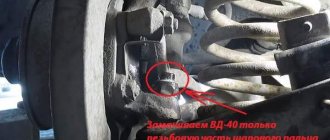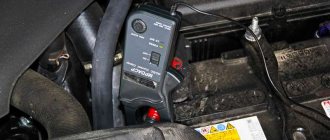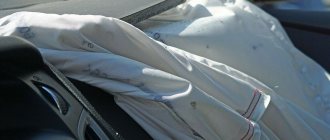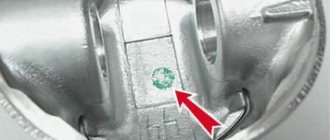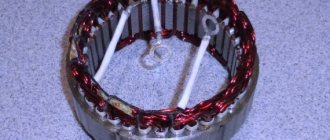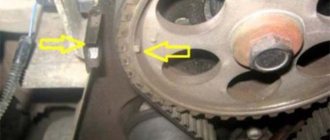How to tell if a ball joint is broken
A faulty suspension element may be indicated by one of four main signs, namely:
- When driving over uneven roads, a distinct knocking sound is heard from the front arches. Its intensity depends on the speed of movement.
- When driving on a flat, straight section of road, the car begins to float from side to side.
- When you turn the steering wheel in one direction, the ball joint makes a squeaking noise.
- The front tires wear unevenly, or rather the wheel on which the broken ball joint is installed wears more. The tire wears off more on the inside.
If at least one of the listed signs is detected, it is recommended to immediately check the vehicle’s suspension elements, namely the ball joints. Diagnosis should be carried out as early as possible. This way you will save on repairs and preserve the life and health of yourself and your passengers.
Symptoms of a problem
It’s good that there are signs by which it is possible to determine the beginning of wear or damage to the ball. Below we describe the most common symptoms:
- knocking noise from under the front wheels when driving over potholes and bumps - as a rule, this indicates wear of the rod or lack of lithol;
- wobbling of the car on the highway - usually caused by the free movement of the finger (the car yaws the more, the higher the speed);
- loss of wheel alignment - this occurs on the wheel where the support fails (checked at a stand in a car service center, such changes are not noticeable to the eye);
- uneven tire wear - if the wheel alignment is lost, then the tires wear unevenly, because the wheel does not stand level to the surface of the tire, but at an angle;
- creaking when turning the steering wheel is a rare symptom for a ball joint, but it also occurs;
- change in direction of movement during braking - the car usually turns a little to one side, just on the side of the broken hinge (at the same time, clicks are heard).
If you notice these signs of wear, take immediate action. Go to the nearest car service center and have the ball joints diagnosed.
Why does a ball joint fail?
There can be only four reasons for the failure of the hinge, these include the following:
- Natural wear and tear of parts. It is worth noting that the resource may vary depending on the manufacturer and correct operation. Before the specified deadlines, only low-quality parts that were manufactured in violation of technology are released. They are much cheaper than original spare parts, so they are popular among many car owners, despite the danger of their use. But even the most reliable part will fail after 120,000 km. If we take into account the influence of additional factors, such as poor road surface, lack of timely maintenance, frequent driving at high speeds, through mud, dust, etc., then the service life is reduced even more.
- Damage to the boot. This part performs a protective function, preventing moisture, dust, dirt, etc. from entering the structure. The boot should be checked periodically for damage. If any are identified, the consumable must be immediately replaced and lubricated with a special lubricant.
- Increased loads on the ball joint. May be caused by aggressive driving style and fast driving. We don't have many roads where you can accelerate a car to 150-200 km/h. Therefore, it is recommended to drive carefully. When driving into a hole, it is the ball joint that bears the main dynamic load. The same thing happens when a driver overloads his vehicle with large weights or tows another vehicle that exceeds the permissible weight limits.
- Drying out of the lubricant. There must be lubricant inside the mechanism. Over time, it may dry out or evaporate. More often this occurs due to damage to the anther. Do not forget to periodically add “Litol” using a syringe or special equipment.
To avoid premature failure of the ball joint, do not spare money on original parts.
It is better not to buy low-quality analogues from little-known brands at a low price at all. They have a very short service life and are also unsafe to use.
Features of individual designs
As mentioned above, this is only the most common version of the ball joint. But there may be, as they say, options.
- removable ball joint.
- a ball joint made integral with the lever.
The same fault detection method is used for all versions.
Video - how a ball joint works when a car is moving:
Important:
Despite its simplicity and reliability, the ball joint has a limited service life. The worse the quality of the road surface on which the car is driven, the greater the chance that the part will fail ahead of time. Failure of this important component can cause a serious accident. The malfunction should be identified at an early stage of its occurrence.
When does the ball joint start to knock?
A knocking sound from a suspension element can only appear when there is a large amount of play, due to severe wear of the part. As we have already found out, you can find out about a malfunction when driving over uneven roads, during turns, braking, etc.
But you should understand that not every wheel knock can be caused by wear of the ball joint. For example, when you hear this sound on a front-wheel drive vehicle only when turning, this may indicate severe wear on the CV joints.
But if the symptoms indicate a ball malfunction, do not delay the check. Diagnostics can be carried out even in the field without a pit or jack. We'll talk about this below. First of all, you need to determine what type of ball joint is installed on your car.
Types of pendants
The method of checking it may also depend on the design of this suspension element. There are two types of pendants:
- Single-lever (MacPherson) - its design features are that the upper part of the wheel and its hub are mounted on a stand, and at the bottom it rests on a lever, which is connected to a ball joint. This type of design is more common on inexpensive cars.
- Multi-link - this mechanism provides for the presence of two levers at once, namely at the top and bottom, to which the steering knuckle is attached. Since there are two levers in the design, there are also two hinges - one on each side.
The vast majority of vehicles have single wishbone suspension types, but we'll look at how to test both options.
Ball joint inspection methods
Today, there are three ways to independently check the condition of a car’s ball joint. In the first case, you don’t even need to remove the wheel and jack up the vehicle. In the second, you will need a jack - with its help you hang the wheels one by one. And the third - using a lift. The last option is only possible in a service station or if you have the necessary installation in your garage. It is with the help of a lift that you can obtain the most reliable information about the condition of the car’s ball joints.
In addition, the diagnostic method may differ depending on the design of the suspension element (single-link or multi-link). First, let's look at how to check a ball malfunction without using a lift, but focusing on knocking, play and degree of wear.
How to check a ball joint
Next, in order, we will consider the algorithm for checking ball joints of different designs. It’s worth mentioning right away that their diagnostics are largely similar. Therefore, the methods can often be applied to different structures.
Checking the upper ball joint on a car
To check the upper multi-link ball joint (or single-link) for possible play, you need to do the following:
- Drive the car onto a level surface.
- Set it to the handbrake.
- Ask an assistant to depress the brake pedal. If no one is nearby, you can try to fix it using improvised means - a heavy object or resting a pry bar on the pedal and seat. This is necessary to eliminate the possible appearance of play in the wheel bearing (if any).
- Take the top of the wheel with your hands and try to rock it from side to side, perpendicular to the direction of rotation (away from you/towards you).
If there is play, then during swinging it will be clearly felt. Also at this moment you can hear creaking, crunching, clicking and similar sounds coming from the ball joint.
Important! Such a check gives results only if the unit is significantly worn; at the initial stage, such actions may not give any result.
Therefore, to obtain more accurate information, it is better to use a jack. The algorithm is almost the same, but you just need to rock the wheel from all sides (top, bottom and sides). To do this, grab the top of the wheel with one hand and the bottom with the other. Swing it in a horizontal plane.
If extraneous sounds are detected (creaks, knocks, crackling sounds), the ball must be replaced with a new one. In this simple way, without removing the wheel and using a lift, you can diagnose the serviceability of the suspension element.
Checking the lower ball joint of a car
As you know, the lower support can only be in a multi-link design. The check is carried out according to the same principle as the top one. To get a more accurate result, drive the vehicle onto an overpass or lift and depress the brake pedal. Next, you will need a pry bar and a jack to check. This method is also suitable for a single lever system.
For ease of inspection, we drive the car onto an inspection hole (lift, overpass). The algorithm of actions looks like this:
- The vehicle is set to the handbrake.
- If a trestle (inspection pit) is used, the wheel to be tested is suspended using a jack. When working with a lift, the car is raised to a convenient height for work.
- Then, very carefully, so as not to tear the boot, the flat end of the mount is inserted between the trunnion and the support lever.
- The mount also swings carefully in a vertical plane. In this way, the hinge being diagnosed is loaded and unloaded. In this case, the ball pin will move up and down.
If the assembly is fully operational, then there will be no play under the mount. Otherwise, you will see and feel the problem immediately. The presence of even slight play indicates failure of the mechanism and the need to replace it.
Important! If you find that the ball joint is faulty on one side, be sure to check the opposite side. Often these units fail in pairs, although the wear rate differs. Replacement of ball joints is also carried out in pairs.
What you need for self-check
In situations where a specialized service center is unavailable for some reason, it is advisable to know how you can independently check the ball joints on your car.
To do this you will need the following:
- lift or inspection hole. At worst, you can do without them, but this will seriously complicate the examination;
- jack. It is necessary when it is not possible to use a lift;
- mount. The flat end of such a tool should easily fit into the space between the pivot pin and the ball joint;
- reliable support. Its size should be such that the support can be easily installed in the space between the lower point of the support body and the floor;
- set of wrenches. Their type and size are selected taking into account the design of the unit;
- ball joint remover. Its type depends on the car model.
Checking the lower ball joint without a lift
This verification method is possible using an additional stop. Stump, cinder block, bricks and the like will do. The main thing is that the item can withstand the weight of the car.
The first step is to jack up the wheel being tested and place a stop under the ball joint, thus loading this unit. If it is working properly, the wheel will remain suspended and rotate freely. At the same time, no extraneous sounds will come from it. If knocking, crunching, or squeaking occurs, you can judge that the suspension element is faulty.
Some cars have a special diagnostic hole in their design. It is necessary to measure the distance from the surface of the ball joint to the base of the pin. If this is present in the design of your car, before checking, look at the tolerances in the technical documentation attached to the vehicle. The measurement is carried out using a measuring device. With such a hole, the diagnostic process is greatly simplified and accelerated.
Replacement
Even a novice car enthusiast can replace the lower ball joint of the front suspension. Let's consider the replacement process using VAZ cars as an example.
Getting ready for work
For work we will need:
- wheel wrench;
- metal brush;
- jack;
- VD-40;
- socket and ring wrenches 13;
- open-end wrench 22;
- sliding pliers;
- ball joint remover.
ATTENTION! A ball joint remover is not cheap, but it greatly simplifies and speeds up the replacement process.
Experts recommend using ball joints, Belmag, Belebey, Kedr, Trek TRS Sport, which are sold complete with or without fasteners. A set with fasteners is more expensive, but it is also more convenient to work with. This kit, in addition to the ball joint, includes a ball stud nut and three bolts with nuts and engravers.
REFERENCE. The upper and lower reinforced ball joints are very similar in appearance. Therefore, manufacturers stamp on them the letters “B” - upper and “H” - lower
Before installation, it is necessary to check the presence of grease under the support boot. If it is not there, add it, but without fanaticism, since excess lubricant can quickly tear the boot.
Progress
We place anti-roll stops under the rear wheels, put the car in gear and the handbrake. Loosen the wheel bolts, lift the car with a jack, finally unscrew the bolts and remove the wheel. We install insurance under the car body; a removed wheel or a wooden block is suitable for this.
If we change the left support, then we twist the steering wheel to the extreme left position, if we change the right support, then to the right. Now we take a metal brush, clean the ball brush and treat it with WD-40 or brake fluid.
We take the 22mm wrench in our hands and unscrew the ball pin nut. Due to the design of the steering knuckle, it will not be possible to completely unscrew the nut. Using VD-40 we process the threads of the ball stud and the nut. Tighten the nut and treat it again with WD-40. We repeat the cycles “unscrewed - poured WD-40 - tightened” until the nut begins to unscrew without effort.
If the replacement is made without a puller for ball joints, then take a soft metal attachment, a sledgehammer and begin to hit the steering knuckle eye with force. As a rule, a few strong blows are enough to loosen the ball joint. If unpressing does not occur, you need to patiently tap the eyelet until the efforts are crowned with success. If you have a puller, dismantling the lower ball joint is greatly simplified and accelerated.
After unpressing the pin, unscrew the fastening nut. If the nut is difficult to unscrew, we use the “Unscrew it, pour it with WD-40, and tighten it.” After the nut is removed, we arm ourselves with 13mm wrenches and unscrew the bolts with which the ball is attached to the lever. We remove the support.
We clean the lower arm from dirt, inspect the place where the support fits on the arm for breaks and cracks. If the lever is damaged, it should be replaced. If everything is in order, then we install a new support, lubricate the finger with lithol, nigrol or motor oil and assemble the parts in the reverse order.
Checking the ball joint boot
When diagnosing a ball joint, you should definitely look at the condition of the boot. This is a rubber element that prevents moisture, dust and other debris from getting into the mechanism from the road during vehicle operation. The boot is a consumable item and therefore must be replaced periodically.
Under the influence of temperature changes, time and other factors, the rubber gradually dries out and cracks appear on its surface. Through them, dust, sand and other debris begin to enter the unit. When mixed with lubricant, it forms an abrasive that will interfere with the normal operation of the mechanism and gradually destroy the metal surfaces of the support.
That is why it is important to periodically check the boot for cracks, debris and quality of lubrication. If damage is found, it must be replaced with a new one. Otherwise, you shorten the service life of the support. When replacing the boot, the cavity must be filled with fresh lubricant - “Litol”, ShRB-4 or analogues.
Tools and accessories
To replace the boot or the entire ball joint on a Hyundai Accent, you will need the following tool:
- Set of keys and sockets.
- Ball puller.
- Rod end puller.
- Jack.
- WD-40 lubricant.
- Pliers for removing retaining rings.
You will also need to purchase the following replacement components:
- Ball for Accent. Catalog number 54503-25A00, 54530-0U000. The price in stores is 450-600 rubles.
- If the support is “alive” and there are cracks in the boot, then it is enough to change only them.
- Litol-24 type lubricant.
The ball is usually supplied with a small amount of lubricant, but it is clearly not enough. Therefore, stock up on such little things in advance. The cost of the boot is, of course, much lower. But immediately assess the condition of the suspension; you can simultaneously replace the silent blocks of the lever.
An alternative way to find out about a ball failure
There is another non-standard verification method. It is suitable for those vehicles where the support is located with the finger up. If water gets into them, it will remain inside, like in a vessel. It can only get there through the oil seal.
If it is difficult to reach or remove the ball joint on your car, a regular medical syringe will help diagnose the problem. Fill it with 2-3 cubes of liquid oil, pierce the boot with a needle and pour lubricant into the cavity.
Now compare the nature of the knocking before and after adding oil. If it has changed, the ball joint has failed and should be replaced. You don’t have to worry about the hole made by a medical needle; water won’t penetrate through it.
Checking the new ball joint
Most new car parts are not always made to the quality required by the vehicle. In particular, this applies to budget brands and spare parts from unknown Chinese manufacturers. Therefore, checking the ball joint is also relevant for new parts.
When buying in a store, first of all, inspect the external condition. If no damage or defects are found, you can move on. The easiest way to check a new or removed ball joint is to turn it upside down. If after this its upper end sank under its own weight or, even worse, the finger fell out, then this indicates a malfunction of the unit.
And even if there is no significant backlash now, it will appear soon. It is also worth moving your finger in different directions on the seat. Movement should not be free and accompanied by even the slightest play. If you apply a little force to perform it, then the part is working properly.
Sometimes in stores there are ball mechanisms in which the finger moves quite tightly. If this part is of good quality, then after moving the finger in any direction, it should move further easily. Otherwise, you should refuse such a purchase.
Another sign indicating a poor quality hinge is the presence of a grease seal or a place to install it. A good part should not have such a mechanism, since it is considered outdated technology.
Reference. A grease fitting is an old name for a grease fitting. It comes from the name of a lubricant that is not currently used - grease. In other words, it is a device for supplying oil.
In addition, the serviceability of the boot on the new ball should be checked. It should be completely free of any cracks or other damage. It is also worth looking at the presence and amount of lubricant - it is important that there is enough of it. If there is little lubricant, you need to add it yourself when installing the part in the car.
The same check can be carried out with a dismantled ball joint, if for some reason you removed it from the vehicle. I would like to say a few words about the repair of this part. All modern ball joints are considered non-repairable. But old models for cars of the Moskvich or VAZ brands are often made with the ability to restore functionality. To do this, you just need to replace the polymer liner.
Service life of ball joints
Modern cars are equipped with ball joints that can easily operate for up to 100,000 km. However, with careful management this period can be significantly longer. Vehicles manufactured more than 20 years ago use parts made using outdated technologies. Their actual service life is no more than 30,000 km.
Before the set time, the hinge part can only come out in the event of mechanical damage and frequent driving on broken roads. When buying low-quality spare parts, you should understand that their service life is much shorter than specified, and moreover, it can break at any time.
Repair of the ball joint is not provided.
Part selection
54530-31600 — original catalog number of the ball joint for the Hyundai Accent. In this case, the name can be indicated as a load-bearing guide hinge. The average price on the market is 1,200 rubles per piece.
Analogs
In addition to the original parts, we can see that there is a list of analogues that can be used on the Accent:
| Manufacturer | Catalog number | Price in rubles |
| Delphi | TC1078 | 600 |
| Moog | MI-BJ-10371 | 900 |
| Lemforder | 29666 02 | 900 |
| Monroe | L42010 | 900 |
| Ruville | 918441 | 900 |
| Blue Print | ADG08636 | 900 |
| 555 | SB-7232 | 900 |
| Moog | HY-BJ-1630 | 900 |
| TRW | JBJ287 | 1000 |
| Febi | 41866 | 1000 |
Is it possible to drive with a broken ball joint?
The design of the ball joint is made in such a way as to eliminate the possibility of the pin falling out of the hole even with very severe wear. A part can be completely destroyed only in extreme cases. For example, under the influence of very large mechanical forces on suspension parts or during long-term operation of a vehicle with a faulty unit.
The main danger of driving with a worn part is that the car pulls to the side when braking. Difficulties also arise when entering a turn. Such changes in management pose a real threat of getting into an accident.
If the ball joints start knocking, you need to understand that driving such a vehicle poses a danger to life and health not only for you, but also for those around you. The appearance of even a slight creaking or knocking sound from the suspension when driving over speed bumps or uneven roads should alert the car owner. You can carry out the simplest check even in the field; for this you do not need to have special devices or complex devices.
